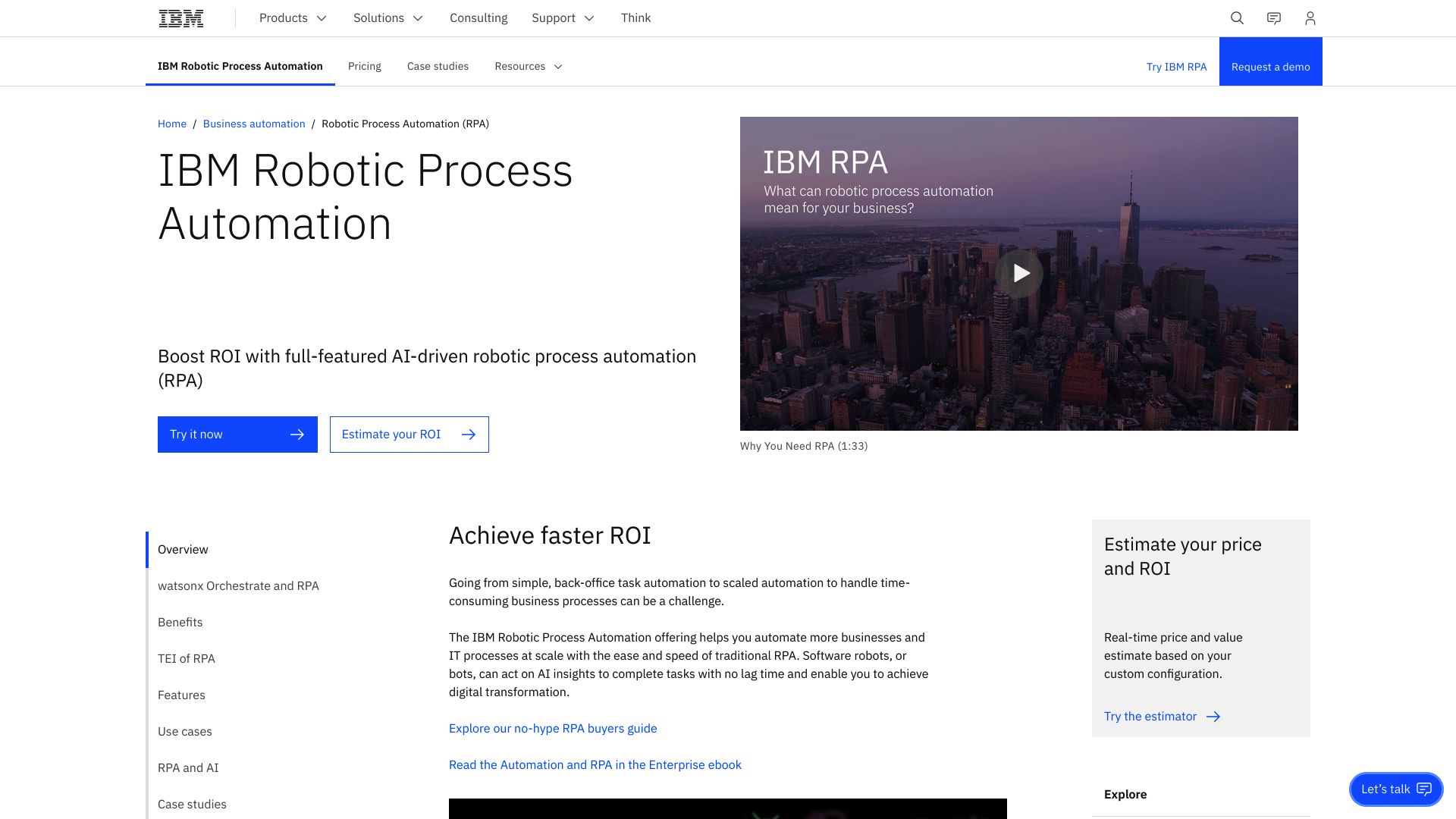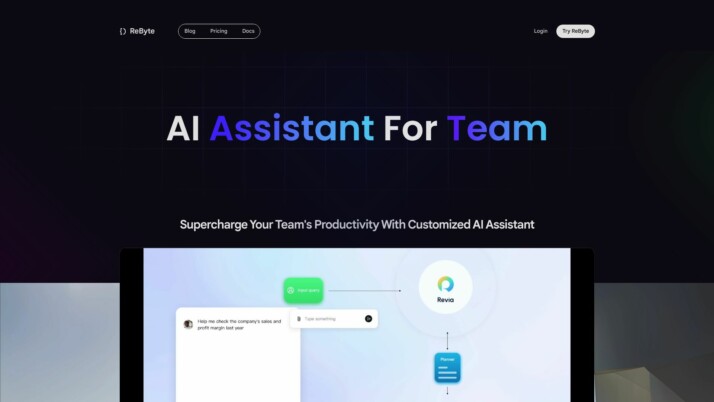IBM RPA vs. Rebyte: Comparing Enterprise and User-Friendly AI Automation
The race for AI supremacy intensifies as businesses seek powerful, accessible solutions to harness this transformative technology. Our comprehensive review compares IBM RPA vs. Rebyte, and SmythOS, three leading platforms revolutionizing workflow automation and AI integration. We explore each platform’s unique strengths, from IBM RPA’s enterprise-grade capabilities to Rebyte’s user-friendly approach, and reveal how SmythOS combines the best of both worlds.
Discover which solution best fits your organization’s needs, whether you’re a developer seeking advanced customization, a business leader focused on scalability and security, or a non-technical user looking to leverage AI without extensive coding. Uncover the key features, integration capabilities, and deployment options that set these platforms apart in the evolving landscape of AI-powered automation.
IBM RPA Overview
IBM RPA empowers businesses to automate repetitive tasks and streamline workflows across diverse enterprise applications. This robust platform enables users to create, deploy, and manage software robots that mimic human interactions with digital systems.


IBM RPA’s visual builder simplifies bot creation, allowing both technical and non-technical users to design automation workflows through intuitive drag-and-drop interfaces. The platform supports attended and unattended bots, catering to scenarios requiring human collaboration and fully autonomous processes. Integration with IBM’s watsonx Orchestrate infuses AI-driven intelligence into automations, enabling more sophisticated decision-making and problem-solving capabilities.
IBM RPA’s visual builder simplifies bot creation, allowing both technical and non-technical users to design automation workflows through intuitive drag-and-drop interfaces.
Scalability stands out as a key strength of IBM RPA. The platform supports concurrent bot execution and distributed runtime environments, allowing enterprises to deploy and manage large-scale automation initiatives efficiently. Security and compliance features, including integration with IBM OpenPages, address critical concerns for enterprise users, ensuring automated processes adhere to governance standards and maintain data integrity.
While IBM RPA offers comprehensive automation capabilities, its enterprise focus may present a steeper learning curve for smaller organizations or individual users. The platform’s integration with other IBM products adds value for existing IBM customers but could potentially increase complexity for those not already invested in the IBM ecosystem. Additionally, while IBM RPA supports API interactions, direct integration with popular automation platforms like Zapier is not explicitly mentioned, which may limit some connectivity options for users.
IBM RPA positions itself as a powerful solution for large-scale enterprise automation needs, emphasizing scalability, security, and AI-enhanced capabilities. Its robust feature set and integration with IBM’s broader technology portfolio make it a compelling choice for organizations seeking to implement comprehensive, intelligent automation strategies across their operations.
Rebyte Overview
Rebyte empowers users to create AI-powered applications without extensive coding skills. The platform’s visual agent builder enables the development of complex AI agents with customizable steps and user interfaces. Rebyte’s serverless runtime handles hosting, orchestration, and deployment, streamlining the entire lifecycle of AI applications.


Key features of Rebyte include integrations with private data sources, detailed observability into agent operations, and a focus on end-user programming through AI. The platform caters to knowledge workers and teams seeking to automate workflows and boost productivity using no-code interfaces.
Rebyte’s approach democratizes AI development, allowing users to transform ideas into deployed applications by simply describing their requirements. This accessibility opens up AI agent creation to a broader audience, including non-technical professionals and business users who can leverage pre-built templates and visual tools.
Rebyte’s approach democratizes AI development, allowing users to transform ideas into deployed applications by simply describing their requirements.
While Rebyte offers powerful capabilities for AI agent development, it may have limitations in areas such as advanced customization for highly specialized use cases or integration with certain legacy systems. The platform’s focus on simplicity and accessibility could potentially limit some advanced features that experienced developers might require for complex projects.
Rebyte positions itself as a bridge between AI technology and practical business applications, enabling rapid prototyping and deployment of AI solutions across various industries. Its emphasis on visual development and managed infrastructure aims to reduce the technical barriers typically associated with AI implementation, making it an attractive option for organizations looking to quickly leverage AI capabilities without significant upfront investment in specialized skills or infrastructure.
Feature Comparison
IBM RPA and Rebyte offer distinct approaches to automation and AI agent development, each with its own strengths and feature gaps. IBM RPA excels in enterprise-grade automation, providing robust tools for large-scale business process automation. Its integration with IBM’s watsonx Orchestrate infuses AI capabilities, enabling sophisticated decision-making in automated workflows. However, IBM RPA lacks direct integration with popular platforms like Zapier and Hugging Face, potentially limiting its connectivity options for some users.
Rebyte, on the other hand, focuses on democratizing AI agent development with its visual builder and no-code approach. While this makes AI accessible to a broader audience, it may lack some of the advanced customization options that IBM RPA offers for highly specialized enterprise use cases. Rebyte’s emphasis on rapid prototyping and deployment is advantageous for quick iterations, but it may not match IBM RPA’s depth in areas like security and compliance features critical for regulated industries.
In terms of core components, IBM RPA’s strength lies in its scalability and integration with enterprise systems, while Rebyte shines in its user-friendly interface and quick deployment capabilities. The security features of IBM RPA, including its integration with IBM OpenPages for governance, outpace Rebyte’s offerings in this area. This gap highlights the differing focuses of the two platforms — IBM RPA on enterprise-grade security and Rebyte on accessibility and speed of development.
Feature Comparison Table
| IBM RPA | Rebyte | SmythOS | |
|---|---|---|---|
| CORE FEATURES | |||
| AI Agents | ❌ | ✅ | ✅ |
| Memory & Context | ❌ | ✅ | ✅ |
| Autonomous Agents | ❌ | ❌ | ✅ |
| Explainability & Transparency | ❌ | ✅ | ✅ |
| Multimodal | ❌ | ❌ | ✅ |
| Problem-Solving Capabilities | ❌ | ✅ | ✅ |
| Multi-Agent Collaboration | ❌ | ❌ | ✅ |
| Work as Team | ❌ | ✅ | ✅ |
| SECURITY | |||
| Constrained Alignment | ❌ | ❌ | ✅ |
| Data Encryption | ✅ | ❌ | ✅ |
| OAuth | ❌ | ❌ | ✅ |
| IP Control | ❌ | ❌ | ✅ |
| COMPONENTS | |||
| Foundation AIs | ❌ | ✅ | ✅ |
| Huggingface AIs | ❌ | ❌ | ✅ |
| Zapier APIs | ❌ | ✅ | ✅ |
| Classifiers | ❌ | ❌ | ✅ |
| Logic | ✅ | ❌ | ✅ |
| Data Lakes | ❌ | ❌ | ✅ |
| DEPLOYMENT OPTIONS (EMBODIMENTS) | |||
| Deploy as Webhook | ❌ | ❌ | ✅ |
| Staging Domains | ❌ | ❌ | ✅ |
| Production Domains | ❌ | ❌ | ✅ |
| API Authentication (OAuth + Key) | ❌ | ❌ | ✅ |
| Deploy as Site Chat | ❌ | ✅ | ✅ |
| Deploy as Scheduled Agent | ✅ | ❌ | ✅ |
| Deploy as GPT | ❌ | ✅ | ✅ |
| DATA LAKE SUPPORT | |||
| Hosted Vector Database | ❌ | ✅ | ✅ |
| Sitemap Crawler | ❌ | ❌ | ✅ |
| YouTube Transcript Crawler | ❌ | ❌ | ✅ |
| URL Crawler | ❌ | ❌ | ✅ |
Best Alternative to IBM RPA and Rebyte
SmythOS stands out as the superior alternative to IBM RPA and Rebyte, offering a comprehensive platform for AI agent development and deployment. Our solution combines powerful features with unparalleled ease of use, making it the ideal choice for businesses seeking to harness the full potential of AI automation.
Unlike IBM RPA’s focus on traditional robotic process automation and Rebyte’s limited AI capabilities, SmythOS provides a full-fledged AI operating system. We enable users to create sophisticated, autonomous agents capable of handling complex tasks across various domains. Our drag-and-drop interface simplifies the development process, allowing both technical and non-technical users to build AI solutions 99% faster than traditional methods.
SmythOS provides a full-fledged AI operating system. We enable users to create sophisticated, autonomous agents capable of handling complex tasks across various domains.
SmythOS excels in its extensive feature set, addressing critical gaps present in both IBM RPA and Rebyte. We offer robust multi-agent collaboration, allowing teams of AI agents to work together seamlessly on complex projects. Our platform supports a wide range of deployment options, including APIs, webhooks, scheduled agents, and integration with popular AI models, providing unmatched flexibility for diverse use cases.
Security and scalability set SmythOS apart from competitors. We implement advanced data encryption, OAuth authentication, and IP control, ensuring that your AI solutions meet the highest standards of data protection and compliance. Our scalable architecture allows for seamless growth, supporting enterprise-level deployments without compromising performance.
By choosing SmythOS, you gain access to cutting-edge AI capabilities, including multimodal interactions, problem-solving abilities, and integration with various data sources and APIs. Our commitment to continuous innovation and user-centric design makes SmythOS the clear choice for organizations looking to stay ahead in the rapidly evolving landscape of AI automation.
Conclusion
IBM RPA and Rebyte offer powerful automation solutions, each with distinct strengths. IBM RPA excels in enterprise-grade automation, providing robust scalability and security features crucial for large organizations. Its integration with IBM’s broader ecosystem enhances its appeal for existing IBM customers. Rebyte, on the other hand, democratizes AI agent development with its user-friendly interface and rapid deployment capabilities, making it an attractive option for smaller teams and organizations looking to quickly leverage AI.
However, SmythOS emerges as the superior choice, combining the best of both worlds. Our platform offers enterprise-grade security and scalability while maintaining an intuitive, user-friendly interface. SmythOS’s extensive integration ecosystem, supporting over 300,000 connections, surpasses both IBM RPA and Rebyte in versatility. Our visual builder enables complex AI workflow creation without extensive coding, appealing to both technical and non-technical users.
SmythOS stands out with its ’Create Once, Deploy Anywhere’ approach, allowing seamless deployment across various platforms and services. This flexibility, combined with our support for multiple AI models and comprehensive documentation, positions SmythOS as the ideal solution for businesses seeking to harness the full potential of AI automation.
We invite you to explore our diverse range of AI-powered agent templates and experience unlimited AI automation risk-free. With SmythOS, you can revolutionize your workflow with AI agents and unlock limitless AI integrations, transforming your business operations and driving innovation at unprecedented levels.
Last updated:
Disclaimer: The information presented in this article is for general informational purposes only and is provided as is. While we strive to keep the content up-to-date and accurate, we make no representations or warranties of any kind, express or implied, about the completeness, accuracy, reliability, suitability, or availability of the information contained in this article.
Any reliance you place on such information is strictly at your own risk. We reserve the right to make additions, deletions, or modifications to the contents of this article at any time without prior notice.
In no event will we be liable for any loss or damage including without limitation, indirect or consequential loss or damage, or any loss or damage whatsoever arising from loss of data, profits, or any other loss not specified herein arising out of, or in connection with, the use of this article.
Despite our best efforts, this article may contain oversights, errors, or omissions. If you notice any inaccuracies or have concerns about the content, please report them through our content feedback form. Your input helps us maintain the quality and reliability of our information.
